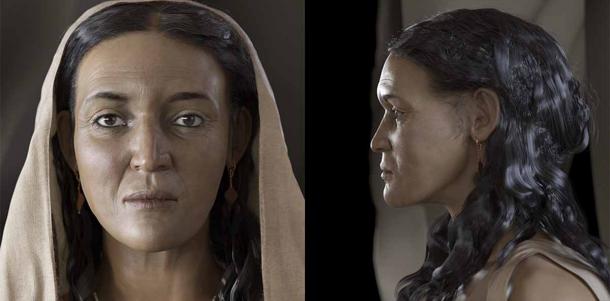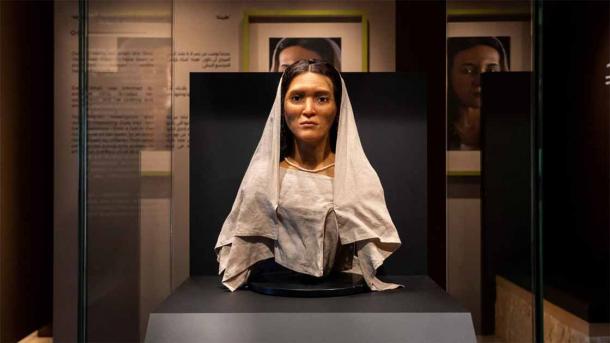Ground-Breaking Tech Brings Us Face-to-Face with a Nabatean Woman
For the first time in history, a team of archaeologists, forensic scientists, and model makers working under the Saudi Royal Commission for AlUla (RCU) have reconstructed the face of an ancient Nabatean woman who lived over 2,000 years ago. The woman, referred to as Hinat, is believed to have been a significant figure who lived around the first century BC, belonged to the elusive Nabatean civilization and was laid to rest in a Hegra tomb in Saudi Arabia.

Front and side view of the ground-breaking facial reconstruction of a Nabatean Woman, referred to as Hinat, whose remains were discovered in a tomb outside Hegra in Saudi Arabia. (Royal Commission for AlUla)
Creating the Facial Reconstruction of a Nabatean Woman
Hinat was discovered in a well-preserved tomb on the outskirts of Hegra, which contained the remains of around 80 people, including several likely relatives. The skeleton of Hinat was found to be in better condition than most in the tomb, leading to her selection for the facial reconstruction project in 2019.
She is believed to have been a wealthy Nabatean woman of high social status, who lived and died in the first century BC.
The reconstruction process involved a diverse team of archaeologists, anthropologists, forensic experts and a 3D sculptor. In September 2019, the team gathered in London to deliberate on Hinat's appearance and attire.
They created a character profile that included references for her clothes, hair, and jewelry and in July 2020 the 3D reconstruction was completed and validated by experts. The specialists then molded a silicon bust of Hinat's face and added her makeup, earrings and her hair, strand by strand. They then dressed her in artisan-woven linen, similar to fragments recovered from tombs at Hegra.
The facial reconstruction of the Nabatean woman is the first of its kind, making it a ground-breaking opportunity to visualize the appearance of the Nabatean people. “One of the problems in Nabatean archaeology and the study of the people is we lack images of them,” highlighted Dr. Christopher A. Tuttle, a Nabatean specialist. “They’re not portrayed very often in their own art, and for many decades of people working at Nabatean archaeological sites, we didn’t have very many human remains.”

The facial reconstruction of the Nabatean woman is the first of its kind. (Royal Commission for AlUla)
Who Were the Nabateans?
The Nabateans initially settled in Hegra in the first century BC after expanding south from Petra and becoming wealthy through their trade of frankincense, spices and other luxury goods in what is now north-west Saudi Arabia. Their cultural heritage is prominently showcased through the elaborate tombs they carved into the sandstone cliffs at Hegra.
An ancient Arabian people who lived in the region that is now modern-day Jordan, Syria and Saudi Arabia, the Nabateans were skilled traders and merchants. Historians believe they originated from the southern Arabian Peninsula, but gradually migrated northwards to establish a trading empire that spanned the ancient world.
Through the control of key trade routes, and prized items like frankincense, spices and textiles, a number of cities along these trade routes were established, including Petra in modern-day Jordan. The Nabateans were eventually conquered by the Romans in the 2nd century AD, but their culture, economy and architectural practices continue to be studied till today.

Hinat, the Nabatean woman whose face has been reconstructed, at the Hegra Welcome Center at in AlUla. (Royal Commission for AlUla)
Grasping the Significance of Reconstructing the Face of a Nabatean Woman
The facial reconstruction of the Nabatean woman dubbed Hinat is a significant achievement that sheds light on the lives of the fascinating Nabatean civilization. It is another example of the ways in which archaeology and history have been fundamentally altered with the presence of artificial intelligence (AI) and technology.
- Were the Women of Petra More Important Than the Men?
- The Architectural Marvel of Madain Saleh and the Enigmatic Nabataean People
It is also a testament to the dedication and expertise of the RCU and its partners, who are committed to uncovering the mysteries of the past and preserving them for future generations. “They’re still a fairly mysterious civilization to a lot of people,” concluded Dr. Helen McGauran, project lead for the reconstruction. “I hope that this project will enable people to engage with the faces, the characters, the story of the Nabateans in a much deeper way than perhaps has previously been realized.”
This remarkable reconstruction of the Nabatean woman is now on display at the Hegra Welcome Centre in AlUla starting from Monday, 6th February 2023, 15 years after Hegra was designated as the first UNESCO World Heritage Site in Saudi Arabia in 2008. The RCU is optimistic about many more noteworthy advancements in the years to come as the laborious work of archaeology across the AlUla region continues to uncover its historical secrets.
Top image: The Nabatean woman, known as Hinat. Source: Royal Commission for AlUla (RCU)
By Sahir Pandey
References
McLean, M. 6 February 2023. “Reconstruction of Nabataean woman to help understanding of ancient civilization” in Irish Examiner. Available at: https://www.irishexaminer.com/world/arid-41065121.html
Saudi Gazette. 6 February 2023. “AlUla exhibits first known reconstruction of Nabataean woman Hinat” in Saudi Gazette. Available at: https://saudigazette.com.sa/article/629605
Zawya. 6 February 2023. “First known reconstruction of 2,000 year-old ancient Nabataean woman unveiled at AlUla, Saudi Arabia” in Zawya. Available at: https://www.zawya.com/en/press-release/companies-news/first-known-reconstruction-of-2-000-year-old-ancient-nabataean-woman-unveiled-at-alula-saudi-arabia-doej43t6




















Comments
If you follow this type of news as I do, you’d probably note the pattern that’s emerging, where the facial reconstructions look a lot like the people doing the reconstructions! If they are not going by the DNA, there’s NO WAY they can determine the color of hair, skin and eyes, or the shape of nose or any features of the flesh. So how did they do it, by looking in a mirror? In others words, this is just a kumbaya thing with absolutely no scientific value, and just further discredits that institution. As I have stated, the best, easiest and probably only valid approach to determining what an ancient person looked like is to sequence the DNA and find the closest living match. The crime labs already do this, so it’s just a matter of running the algorithm. Maybe the closest match is a blonde from Russia - we don't know. But let's find out.
Nobody gets paid to tell the truth.